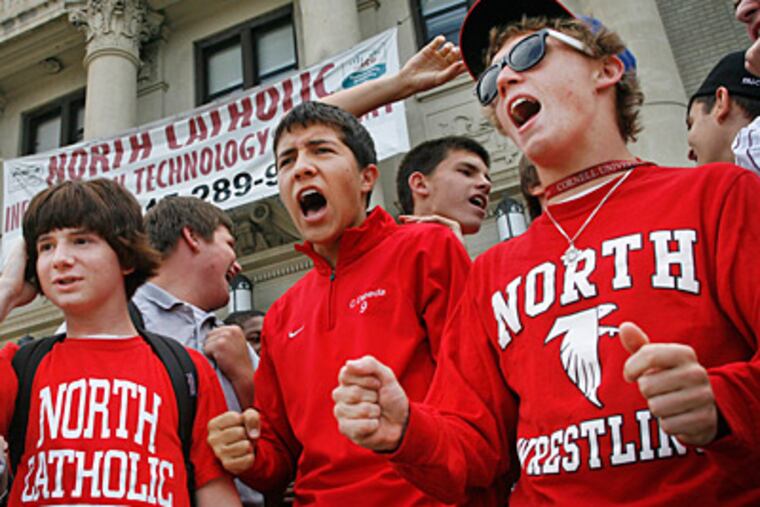Catholic schools shift with the population
At the same time that the Archdiocese of Philadelphia is closing two venerable Catholic high schools in the city in June, it is preparing to open a new high school in the suburbs in the fall and plans to build another in a few years.

At the same time that the Archdiocese of Philadelphia is closing two venerable Catholic high schools in the city in June, it is preparing to open a new high school in the suburbs in the fall and plans to build another in a few years.
Cardinal Dougherty and Northeast Catholic High School for Boys are the latest casualties of the archdiocese's perennial problems in the city of rising costs, falling enrollment, and competition from publicly funded charter schools.
Meanwhile, the $65 million Pope John Paul II High School, rising on 92 acres near Royersford, is a beneficiary of the exodus of Catholic families to the booming corners of western Montgomery County.
The shift in emphasis from the city to the suburbs is fueled by demographic changes that began decades ago and reflects decisions by church leaders to follow Catholic families to the edges of the five-county archdiocese.
It's all part of a long-range plan to make sure Catholic schools are an option for all Catholic families, Bishop Joseph P. McFadden said Thursday when the high school closings were announced.
"Our hope is that Catholic secondary education will be available in every area of the diocese and will be accessible," said McFadden, auxiliary bishop who oversees Catholic education.
Enrollment at coed Dougherty, once the largest Catholic high school in the world, soared to nearly 6,000 students in 1965. It has plunged more than 43 percent during the last decade and was projected to fall an additional 34 percent in the next three years.
The massive building at 6301 N. Second St., which once had separate wings for boys and girls, has the capacity for more than 2,000 students, but only 640 attend this year.
At North Catholic - as the boys' school is known - enrollment dropped 29 percent in the last decade and was forecast to decline an additional 24 percent in three years despite efforts by school officials and alumni to boost enrollment and raise money to support the school.
The school, at 1842 E. Torresdale Ave., enrolled 4,410 at its peak in 1953. It has the space these days to educate 1,700 but has only 551.
"The critical reason for the closures of these schools at this time in our history is directly related to the steady decline in these schools' enrollment," McFadden said.
He pointed out that with fewer Catholic families living in the city, several nearby parish elementary schools closed in recent years. The closing of Catholic elementary schools has a direct impact on high school enrollment.
"Eighty percent of our secondary pupils come from our elementary schools," McFadden said. "In those areas, around those two schools, they have just dried up."
He said declining birthrates were another factor that had led to the painful decision to close the schools.
"One of the issues that people sometime forget is that a number of these schools were built during the period of the baby boom," he said.
In fact, the heydays of North Catholic and Cardinal Dougherty coincided with the golden years of the archdiocese immediately after World War II. As the baby boom hit, Catholic families settled into close-knit parishes. Families with four or five children sent them to the parish elementary schools and on to their assigned archdiocesan high schools.
But between 1950 and 1960, enrollment at the parish schools began to shift as more families moved from neighborhoods such as Germantown, Port Richmond, and Fishtown - sometimes to the Greater Northeast but often to the Pennsylvania and South Jersey suburbs.
In 1950, 76 percent of the 111,311 students in parish elementary schools lived in the city. That percentage had dropped to 58 by 1960, when a peak of 195,079 children attended parish schools, according to an enrollment history provided by the archdiocese.
Seventy percent of the 41,462 students in archdiocesan high schools still lived in the city in 1960, but it has been downhill ever since.
City students accounted for 48 percent of enrollment at the 20 archdiocesan high schools in 2008-09.
The total attending archdiocese high schools has declined, too. The high point was 58,113 in 1970.
As tuition has climbed - it's $5,100 for Catholic students this year - many city families have opted for charter high schools, which are free. And Catholic schools in the suburbs often compete for students with top-notch public high schools.
A total of 19,227 students attended Catholic high schools a year ago in the five-county archdiocese. This year, there are 18,200 - a dip of just under 5 percent.
The archdiocese hopes Pope John Paul II High School, with its high-tech facilities and playing fields, will help reverse that trend. While the school will enroll students from Kennedy-Kenrick Catholic High School in Norristown and St. Pius X High School in Pottstown, which are closing, the archdiocese hopes it will attract others.
McFadden pointed out that even with the closing of Cardinal Dougherty and North Catholic, eight archdiocesan high schools will remain in the city.
"Catholic education is very much alive and available to those students," McFadden said.
He conceded students may have to travel a little farther. But he said the archdiocese would help the nearly 1,200 students from those schools transfer to neighboring Catholic high schools.